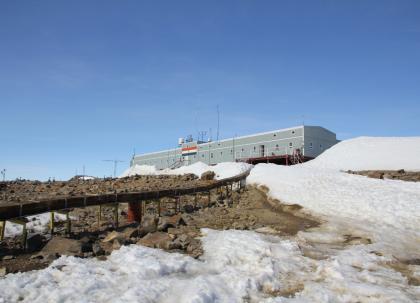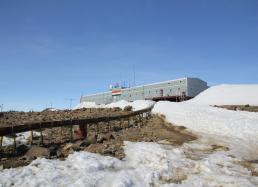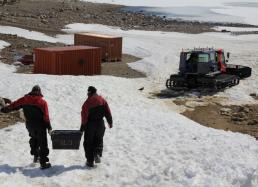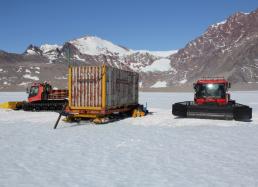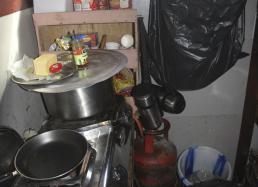3. From Maitri to Untersee
I’ve just returned from a quick trip to Lake Untersee, and I thought I’d catch you up on our experiences there, since we had no internet access while at our remote camp….
Last Sunday, I and my colleagues from the Geological Survey of India (GSI) headed out from Maitri Station (see above photo and Photo #1 below) to begin our initial fieldwork project: conducting a geophysical survey of Untersee, a permanently ice-covered freshwater lake in the Gruber Mountains.
Our objective was to measure the ice thickness and depth of the lake by using ground-penetrating radar (GPR), and to collect rock and soil samples from the lakeshore and lake bottom. (Check out photos of Lake Untersee in our Expedition Overview Photo Gallery.)
Our first field team consisted of two fellow geologists, Mr. Ashit Swain (pronounced: Ah-seet Svey) and Mr. Raghuram, both from GSI. Included in our numbers were three technicians who piloted and maintained our two heavy-duty vehicles (German-made Pisten Bullies), as well as the station leader and commander of the 32nd Indian Scientific Expedition to Antarctica, Mr. Neghi.
The station’s meteorologist, whose room is located just across the hall from mine at Maitri Station, told us that the weather forecast for the next six days was good, so we were safe to go. No storms were predicted and the skies appeared to be clear or partly cloudy, however, lower temperatures and strong winds were expected to arrive toward the end of our trip.
The day of our departure started early for some of Maitri Station’s members. The cook and kitchen crew got up at four in the morning to prepare an early breakfast (delicious dosai) and a freshly cooked lunch (tasty chicken biryani) for us—which I thought was an extremely generous gesture.
Before departure, the field team and station members got together for a friendly, pre-field dispatch tradition—a puja (an act of worship), held to protect the team members in the field and ensure a favorable outcome of the fieldwork.
With the two Kässbohrer Pisten Bullies and a living-module container in tow—all loaded with supplies designed to sustain a team of seven during a week of fieldwork (see Photo #2 below)—we headed out for our 75-mile (120-km) trip over the continental ice sheet. It was quite impressive to see how effortlessly a 300-horsepower Pisten Bully could tow the living-module container, which, when empty already weighs more than two tons, but when fully loaded weighs 20 tons.
To plan our route across the ice, Dale Andersen and his team of geobiologists (who had deployed to Untersee two weeks earlier) sent us their GPS travel coordinates. The drivers strictly followed that route to avoid any dangerous ice crevasses that were too large to cross with the vehicle.
We did encounter a few small crevasses, about three feet (one meter) wide, that we could easily traverse. I must admit that, although I trusted the experienced driver, I felt a little bit uneasy during my first official trip across one of these gaping openings as I gazed down into it from my perch in the vehicle.
The journey took us about 12 hours, including breaks: the first one being a stop for tea about two hours into the trip, followed by lunch, as well as a couple of refueling stops. (We carried barrels of fuel and an electrical pump with us—see Photo #3 below.) Despite a bumpy ride, the three of us in the passenger cabin did manage to get a few hours of sleep.
After a long and impressive journey, we reached our destination in the early morning hours and set up camp on the Anuchin Glacier. We purposefully selected a site near a snow patch (see Photo #4 below), which came in handy for cooking and drinking water, since the glacier ice is far too hard to remove.
Our living module came equipped with a small kitchen, where we prepared a late dinner of quite tasty, ready-made food (see Photo #5 & 6 below.) The module even contained a simple toilet and seven bunk beds! We named the living module, the “Maitri Express,” because when the wind shook the container, we felt as if we were riding in a train sleeper compartment.
After “gently” rocking to sleep, we awoke around noon the next day to begin our first day of fieldwork….
More soon,
Philipp R. Heck, Ph.D.
The Robert A. Pritzker Assistant Curator of Meteoritics and Polar Studies
A Tawani International Expedition

